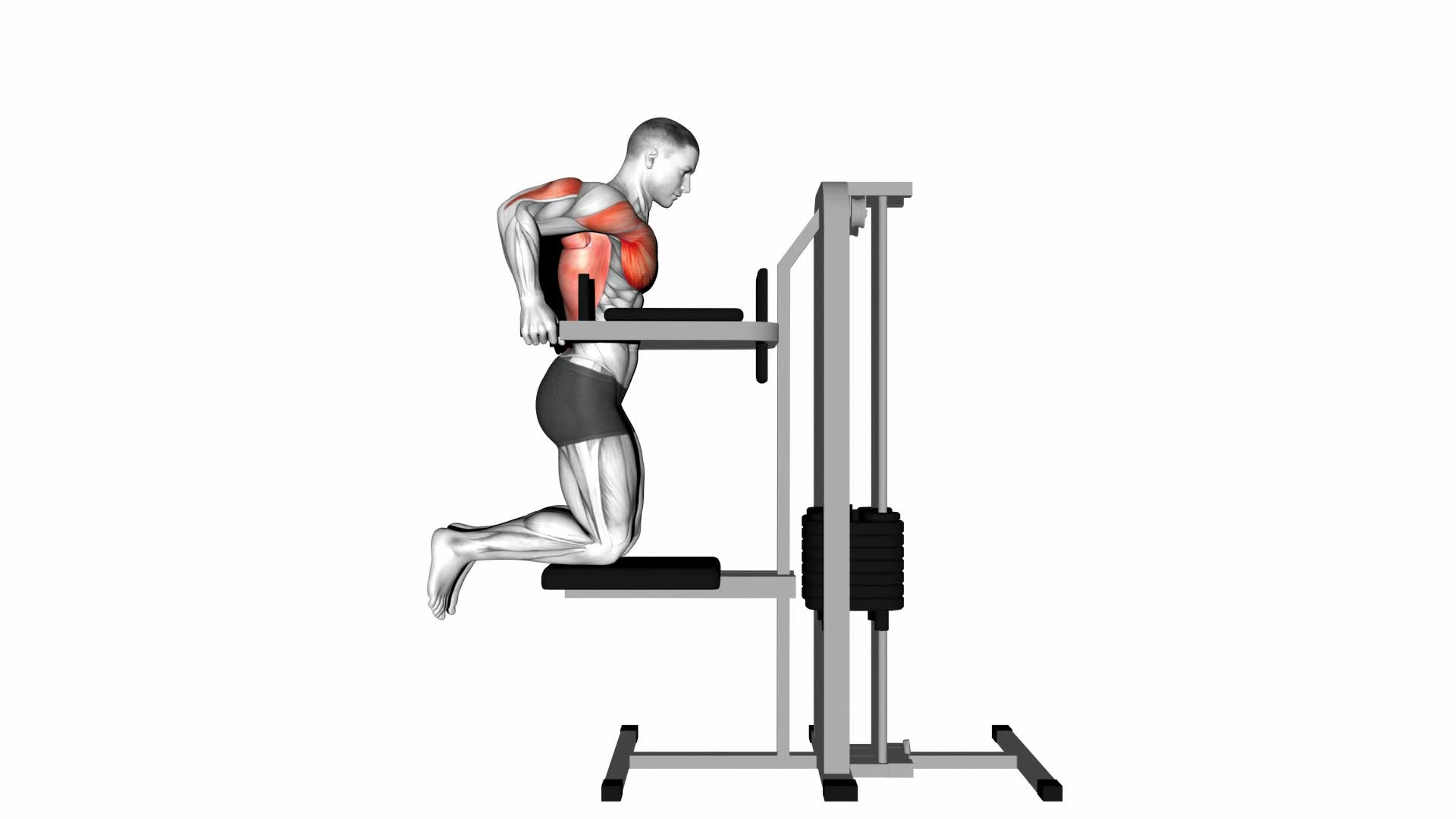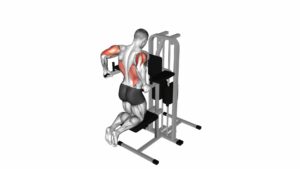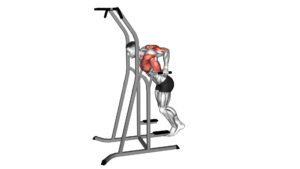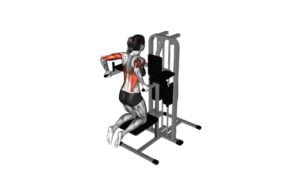Assisted Chest Dip (kneeling) – Video Exercise Guide & Tips

Feeling overwhelmed by the thought of chest dips? Assisted Chest Dip (kneeling) can be a game-changer! This blog will equip you with an easy-to-follow video guide, tips to nail correct technique, and advice on variations for progression.
Watch This Exercise Video
Ready to dive in and work those muscles like never before?.
Key Takeaways
- The Assisted Chest Dip (kneeling) is a machine – assisted exercise that targets the lower chest and triceps, making it suitable for beginners or those with limited upper body strength.
- To perform the Assisted Chest Dip, start by kneeling on the dip machine with your knees supported and your hands gripping the handles. Slowly lower your body down towards the handles, keeping your elbows close to your sides and maintaining a straight torso.
- Maintaining proper form is crucial when performing the assisted chest dip (kneeling) to ensure maximum results and minimize the risk of injury. Keep your core engaged, elbows slightly bent, and shoulders down and back. Avoid swinging or using momentum to lift yourself up.
- The assisted chest dip targets not only the lower chest and triceps but also engages secondary muscle groups such as the front shoulder, upper chest, and triceps. This compound pushing exercise helps build strength in these areas for improved upper body fitness.
What is the Assisted Chest Dip (Kneeling)?
The Assisted Chest Dip (Kneeling) is a machine-assisted exercise that targets the lower chest and triceps, making it suitable for beginners or those with limited upper body strength.
Machine-assisted exercise
Machine-assisted exercises, such as the kneeling chest dip, provide a safe training method to build strength and functionally train muscle groups. The design of the machine aids in maintaining correct technique throughout each movement which reduces risk of injury while promoting maximum results.
Assisted dips focus primarily on activating lower chest and triceps muscles, making them a perfect addition to any upper body workout routine. With equipment set up for resistance-based kneeling variation dips, users can adjust weight to meet their fitness level making this compound pushing exercise accessible and effective for everyone from beginners to experienced athletes.
The built-in assistance prevents straining unprepared muscles but still ensures an intensive work-out that enhances overall conditioning strength.
Targets the lower chest and triceps
The assisted chest dip exercise specifically targets the lower chest and triceps muscles. By performing this compound pushing exercise, you can effectively strengthen and tone these areas for improved upper body strength.
Whether you’re a beginner or have limited upper body strength, the assisted chest dip is a great choice to build muscle and increase overall fitness. With proper form and technique, you can achieve maximum results and see noticeable improvements in your chest and triceps muscles.
Suitable for beginners or those with limited upper body strength
This variation of the assisted chest dip is perfect for beginners or individuals who have limited upper body strength. By using the machine-assisted exercise, you can gradually build your strength while targeting your lower chest and triceps.
This allows you to perform the exercise with proper form and maximum results, even if you are just starting out or working on improving your upper body strength. With this kneeling variation, you can engage in compound pushing exercises that will help strengthen and condition your muscles effectively.
So whether you’re new to fitness or looking for a way to ease into chest dips, this assisted variation is an excellent choice for building upper body strength.
How to Perform the Assisted Chest Dip
To perform the Assisted Chest Dip, start by kneeling on the dip machine with your knees supported and your hands gripping the handles. Slowly lower your body down towards the handles, keeping your elbows close to your sides and maintaining a straight torso.
Push through your palms to return to the starting position and repeat for desired reps.
Starting position
Position yourself on the assisted chest dip machine with your knees resting on the provided padding. Place your hands on the parallel bars with palms facing down and grip firmly. Your arms should be fully extended, supporting your body weight.
Keep your core engaged and maintain a slight forward lean to activate your chest muscles. This is your starting position for the assisted chest dip exercise.
Execution
To perform the Assisted Chest Dip (Kneeling) exercise, start by adjusting the machine according to your height. Grasp the handles with an overhand grip and kneel down on the padded platform.
Your knees should be supported and your feet lifted off the ground. Begin by lowering yourself down slowly, bending at the elbows until your upper arms are parallel to the floor. Then, push yourself back up to complete one repetition.
Make sure to engage your chest muscles throughout the movement and maintain control of your body.
Tips for proper form
Maintaining proper form is crucial when performing the assisted chest dip (kneeling) to ensure maximum results and minimize the risk of injury. Start by positioning yourself on the machine with your knees resting on the pads and gripping the handles firmly.
As you lower your body, keep your core engaged, elbows slightly bent, and shoulders down and back. Avoid swinging or using momentum to lift yourself up. Instead, use controlled movements and focus on contracting your chest muscles throughout the exercise.
Remember to breathe steadily throughout each repetition for optimal performance.
Benefits and Muscles Worked
The assisted chest dip targets the lower chest and triceps, while also engaging secondary muscle groups such as the front shoulder, upper chest, and triceps. Discover how this exercise can benefit your upper body strength in our comprehensive guide.
Primary muscle groups (lower chest and outer triceps)
The assisted chest dip primarily targets the lower chest and outer triceps. This compound pushing exercise helps to build strength and definition in these muscle groups. By engaging the lower chest, you can develop a more rounded and sculpted appearance.
Additionally, working the outer triceps can improve arm definition and enhance overall upper body strength. The assisted chest dip is an effective exercise for targeting these specific areas to achieve maximum results.
Secondary muscle groups (front shoulder, lower triceps, upper chest and triceps)
The assisted chest dip not only targets the lower chest and triceps, but it also engages several secondary muscle groups. These include the front shoulder, which helps with stability during the exercise.
The lower triceps are also activated as they assist in extending the arm while performing the dip. Additionally, both the upper chest and triceps muscles are worked due to their involvement in pushing movement during each repetition.
By targeting these secondary muscle groups along with the primary ones, you can maximize your results and develop overall upper body strength.
Variations and Alternatives
Explore different variations of the assisted chest dip, including band-assisted dips, machine fly exercises, and one-arm hammer-grip dumbbell bench presses. Discover these alternatives to challenge your muscles in new ways and achieve maximum results.
Use of bands for assistance
To provide assistance during chest dip exercises, you can use bands. These resistance bands help support your bodyweight and make the exercise more manageable, especially for beginners or those with limited upper body strength.
By attaching one end of the band to a sturdy anchor point and looping the other end around your shoulders or under your knees, you can gradually decrease the amount of assistance as you become stronger.
This allows you to progress at your own pace while still getting the benefits of a challenging workout.
Machine fly
The machine fly is a popular exercise that specifically targets the chest muscles. To perform this exercise, sit on the machine and grab onto the handles with your palms facing inward.
Push your arms forward until they are parallel to each other, then slowly bring them back to the starting position. This movement helps in developing strength and definition in the chest muscles.
It is important to maintain proper form throughout the exercise by keeping your back straight and using controlled movements. By incorporating machine flies into your workout routine, you can effectively work on your chest muscles for maximum results.
One-arm hammer-grip dumbbell bench press
The one-arm hammer-grip dumbbell bench press is an effective variation of the traditional dumbbell bench press exercise. This exercise targets your chest muscles, triceps, and shoulders while also engaging your core for stability.
To perform this exercise, lie on a flat bench with a dumbbell in one hand and your palm facing inward (hammer grip). Press the weight up towards the ceiling while keeping your arm straight and controlled.
Lower the dumbbell back down to chest level and repeat on the other side. This unilateral movement helps to improve muscle imbalances and can provide a different stimulus for your upper body strength training routine.
Conclusion and Final Thoughts
In conclusion, the assisted chest dip (kneeling) is a great exercise for those looking to target their lower chest and triceps. It’s perfect for beginners or individuals with limited upper body strength.
By following the correct technique and using necessary equipment, you can maximize your results and develop upper body strength effectively. So, give this compound pushing exercise a try and incorporate it into your upper body strength training routine!
FAQs
1. What does the Assisted Chest Dip (kneeling) – Video Exercise Guide & Tips provide?
This guide provides necessary equipment information, pro tips, and video tutorials for correctly performing assisted bodyweight exercises like Chest Dips.
2. How can machine-assisted and band-assisted dips improve my upper body strength?
Machine-assisted and band-assisted dips are effective strength and conditioning exercises that activate muscle groups in your upper body, enhancing overall strength.
3. What variations of chest dip exercises are available?
A variety of chest dip variations exist to challenge your resistance training exercises, including the tricep dips or assisted dip alternatives.
4. Are there any progression techniques for Bandasssited dips?
Yes! The exercise guide includes bandassisted dip progressions to intensify your gym workout techniques gradually.
5. Can I learn correct technique for chest dips from this guide?
Definitely! The Assisted Chest Dip guide contains video tutorials demonstrating the correct technique for performing chest dips with all necessary equipment.

Author
Years ago, the spark of my life’s passion ignited in my mind the moment I stepped into the local gym for the first time. The inaugural bead of perspiration, the initial endeavor, the very first surge of endorphins, and a sense of pride that washed over me post-workout marked the beginning of my deep-seated interest in strength sports, fitness, and sports nutrition. This very curiosity blossomed rapidly into a profound fascination, propelling me to earn a Master’s degree in Physical Education from the Academy of Physical Education in Krakow, followed by a Sports Manager diploma from the Jagiellonian University. My journey of growth led me to gain more specialized qualifications, such as being a certified personal trainer with a focus on sports dietetics, a lifeguard, and an instructor for wellness and corrective gymnastics. Theoretical knowledge paired seamlessly with practical experience, reinforcing my belief that the transformation of individuals under my guidance was also a reflection of my personal growth. This belief holds true even today. Each day, I strive to push the boundaries and explore new realms. These realms gently elevate me to greater heights. The unique combination of passion for my field and the continuous quest for growth fuels my drive to break new ground.







